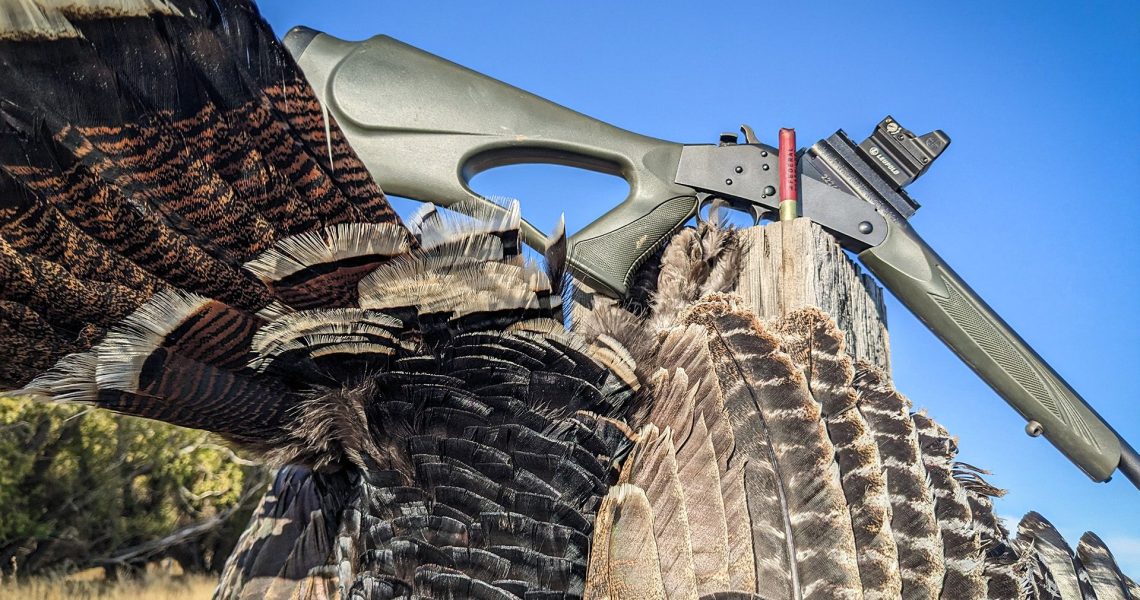East Vs. West: A Turkey Hunting Showdown!
By Todd Helms & Dan Turvey, Jr
The East is Least-
By Dan Turvey, Jr.
In 2006 I started getting serious about chasing gobblers in Michigan (where I lived at the time). My uncle owns about 60 acres in SE Michigan and for those familiar (or not), huntable land is at a premium there. Most of it is locked up by other hunters and the places that aren’t, have owners that are less than enthused about our sport.
At any rate, one spring evening we were sitting on my uncle’s deck. It was the kind of evening where the chill of winter and warmth of summer intertwined causing us to don hoodies and reminisce about the past winters hunts and talk predictions of our summer adventures to come. The smell of grilling steaks and morel mushrooms wafted through the spring air as barley and malt entertained our taste buds. Our conversation was intermittently broken by the splash of largemouth bass crashing the banks of his pond chasing their next meal.
Darkness was fast approaching and flames threatened to escape their prison bars as my uncle flipped our steaks with care. I brought that chocolate brown bottle to my lips and as I took a sip of its golden contents, a thundering gobble chimed into the symphony of sizzling steaks, good conversation and splashing bass. In unison (as if we aren’t related) my uncle and I snapped our heads to the east, bailed off the deck away from the noise of sizzling steaks and strained our ears. Another gobble echoed through the oak trees and the hair on the back of my neck stood up! We looked at each other with excitement written across both our faces. We sauntered back towards our waiting steaks and started hatching plans for the following day as that bird lit up from his roost for the next hour, well into dark.
Being rookies to turkey hunting, the following evening found my uncle and I under a likely roost tree (identified by a few dropping and feathers) with little more than a shotgun and camo. As darkness approached so did that bird. At first we heard him gobble on the other side of the wood lot in a freshly planted crop field. A few minutes and many gobbles later he was at full strut some 52 yards out. I put the bead of my 870 on his major caruncles and touched it off. I barely got up before my uncle was half way to that bird and I was hooked for life!
The jake flopped its last as I proudly wrapped my tag around his leg and hefted his weight over my shoulder while feeling like a “real” turkey hunter. Little did I realize…
With the fire for turkey hunting now a blazing furnace, I started on my quest to take a tom every spring. I successfully killed birds from 2006-2010 in Michigan then I left for a job opportunity in Nebraska. The five-year, perfectly pitched game ended but the series was far from over.
So what does all this lead to? Well, my approach to consistently taking birds in the eastern states changed little over the years. I didn’t realize it at the time but a recent conversation with a friend from Indiana shed some light on the way I hunted. A little background on my friend Sarah, she’s a competition winning caller, very accomplished hunter and a turkey’s worst nightmare. So needless to say, she knows what she’s talking about.
I quipped to her that the way I hunted turkeys was without decoys and calls because I am a terrible caller. Rather, I would find their roosts and fly down landing zones. I would sneak into the area at 3:30 a.m., sitting quietly in the dark for hours within gun range of the fly down zone that wasn’t much more than 20 feet in diameter. As the cold and quiet of night gave way to the warmth and light of day, the birds started gobbling and getting restless on the roost above me. My excitement level would skyrocket and the cold that seeped into my bones rapidly disappeared.
When they flew down in a racket, my safety would click off. The first big tom that hit the zone would stretch his wings, gobble then spit and drum. As that puffed up bird rotated into a gap between the big oaks I sent a 1-1/2 oz. load of #5’s on its way. I filled four consecutive tags in that fashion and not to mention my dad whom I introduced the method to, taking several birds as well.
She said, “That’s what makes a good turkey hunter! You don’t have to be a good caller!”
This coming from a competition-winning caller! In that moment it made perfect sense after all these years! There’s a difference between hunting turkeys and calling turkeys. Yes, both are effective in their own right but for me, I found an incredible amount of success in the East just doing my homework diligently.
I also learned that turkeys (when they can) are very selective about their roost trees. The old oaks with big, wide horizontal limbs were not preferred in my area. I honestly think they felt less secure from predators in such a tree.
On the flip side, the trees with limbs that could barely hold their body weight were also not roosted in. There seemed to be a middle ground. Branches about as wide as your wrist, that were mostly horizontal, on a very tall tree that was right smack dab on the middle of the highest oak ridge I could find. I found three such areas and through precision scouting, I identified the fly down zones for each tree. One such zone was actually on the next ridge over and I never would have known that without first finding the roost then sitting within binocular range of that roost watching birds fly down in the morning.
There’s also another rarely talked about turkey habit in areas like this. The birds have what I call a “fly up” area. If left undisturbed, turkeys actually have an area where they prefer to fly up into the roost. The fly down and fly up areas are not necessarily the same spot either. Typically, toms are less vocal later in the day towards evening and finding a fly up spot, and slipping in well ahead of the birds’ arrival can also fill more tags for you.
Now, when I moved to western Nebraska for that job I told you about earlier, well the game changed. Running and gunning with long distance calling to bring those toms in was very successful. I am sure Todd will enumerate the multiple ways not having calls and decoys with you is sacrilege but the success speaks for itself.
We should probably hear what he has to say though, this should be good…
The West is Best?
Todd J. Helms
Dan, Dan, Dan… thou shalt not venture into the turkey woods without calls! Seriously, I mean who does that? Oh well, in all seriousness, one does not need to be an expert caller to kill turkeys but it helps.
My own adventures into turkey calling were spurred on by an ancient box call of my grandfather’s, not that he was a magician with it but it got me started. As I’ve stated in previous Wingmen articles I’ve always been a sucker for hunting anything I could “talk to.” From an early age duping animals by convincing them I was one of them has captivated me. That old box call led to one of my own and numerous seminars by experts like Walter Parrot and Eddie Salter. The knowledge gained from those “gurus of the gobble” eventually led to me clucking and purring in my very first tom and I’ve never looked back.
But what about the differences between calling in notoriously difficult Eastern birds and their more, shall we say, naïve western cousins, the Merriam’s and Rio? Well from my experience the western birds tend to be more vocal at all times of the day. Where an Eastern will gobble in the tree before flying down and then shut up only to sneak in silently or worse yet just flat walk away, a Merriam’s not only gobbles his head off on the roost but quite often will continue to do so upon hitting the ground as he spits and drums his way into your setup.
Is this always the case? Of course not. Especially later in the season when birds have wised up a bit. However, the biggest difference that I can see between the two species is hunting pressure. Turkey hunters in the West are fortunate to simply not have to deal with the amount of hunting pressure present in the eastern states. This leads to birds that are more willing to come to a call throughout the season. I’m sure some of you will argue with this and I will concede that I’ve had my butt handed to me multiple times by a wary Merriam’s, especially mature birds who’ve survived three or more hunting seasons. Yet, I maintain that Merriam’s especially are much more susceptible to good calling than their eastern counterparts.
There is also another distinct difference between the two populations – competition. It is not uncommon early in the western seasons for gobblers to be congregated into flocks unrivaled by eastern birds. I’ve personally seen roosts with 100 or more birds on them. This leads to very intense competition for hens and a well-placed strutter decoy during the early parts of the season in the western states, more often than not, means fast and furious action as the toms are feverishly establishing pecking order.
Case in point, I remember one opening day in Wyoming where four of us set up a hen and “stuffer” strutter a couple hundred yards from a roost holding about 200 birds. A few yelps into the morning as we sat in one place and killed four nice toms without one of us even getting up. It was an unreal experience and one that would never have happened in the East. But what happens when even our western birds refuse to come to the call?
This is where the biggest difference between East and West comes to bear – stalking. Yes, I said it! Stalking toms in the West is very possible and quite often a deadly tactic. The biggest difference here is topography. As any eastern turkey hunter will tell you, movement is your biggest enemy and busts more sets than any other factor in turkey hunting. Now the recent craze in “reaping” aside, eastern birds will nab you nine times out of ten if you try to move on them. So why is creeping in on western birds effective? Terrain. The topography of the West quite often allows hunters to keep tabs on a gobbling but locked up bird while staying out of sight and closing the gap. Remember, hens go to toms and so calling in a gobbler is the exact opposite of what they are programmed for.
While it quite often works, when it doesn’t one of my go to tactics in the West is to use the terrain to close the distance and when I’m within 60 yards and still out of sight, begin purring and soft clucking to sweet talk that gobbler into shotgun or bow range. This works! I’ve employed this ruse many times, especially later in the season or during the mid-morning when the birds are “henned-up.” The secret is cutting the distance unseen to 70 yards or less, that way a wise old tom doesn’t have to come very far to collect what he thinks is a wayward hen. This is much like sneaking in on a herd of elk and coaxing the bull into bow range.
I realize that there are many ways to kill a gobbler both East and West and that what I’m saying here may seem counter-intuitive to died in the wool sit and call or sit and ambush turkey hunters but trust me, there are differences between eastern and western turkeys, and those differences while hunting in the West can be exploited by the savvy turkey hunter and often mean the difference between success and failure.

Editor’s note: With the recent tragic events involving turkey hunters being shot and killed while attempting to put a sneak on or “reap” a gobbler, we must advocate for supreme caution when attempting to “move” on a tom. Please be careful and be aware that especially on public land in the West where shooting turkeys with rifles is legal, it may behoove aggressive hunters to think twice before attempting these methods. Be careful out there and enjoy the spring turkey woods!









